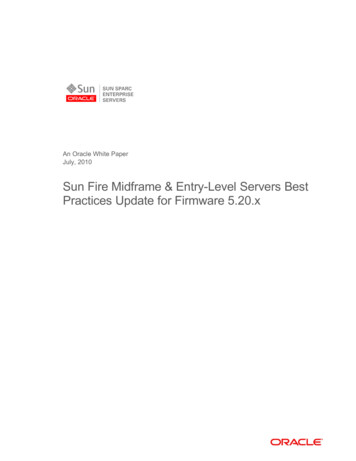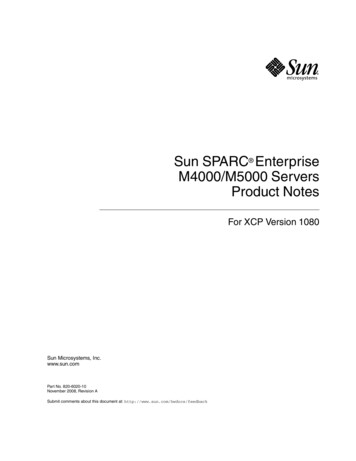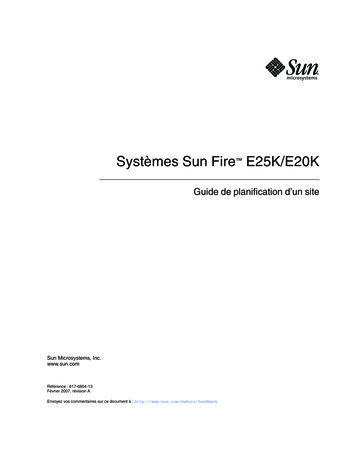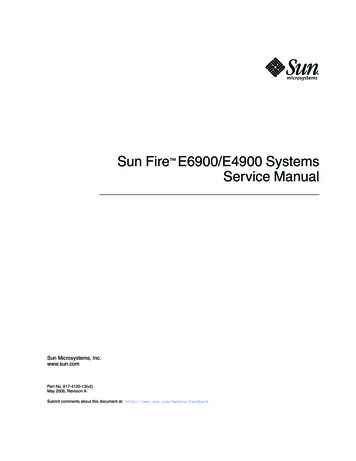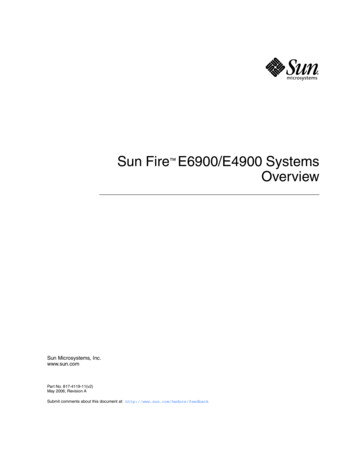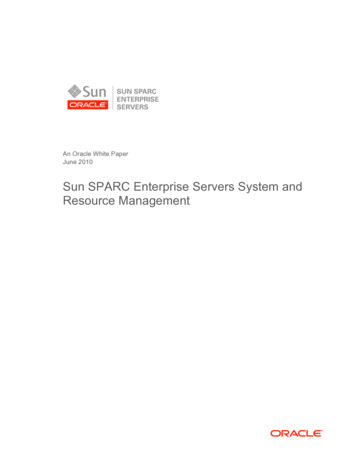
Transcription
Securing the Sun Fire Midframe System ControllerBy Alex Noordergraaf - Enterprise Engineering andTony M. Benson - Enterprise Server ProductsSun BluePrints OnLine - September 2001http://www.sun.com/blueprintsSun Microsystems, Inc.901 San Antonio RoadPalo Alto, CA 94303 USA650 960-1300fax 650 969-9131Part No.: 816-1942-10Revision 1.2, 10/02/01Edition: September, 2001
Copyright 2001 Sun Microsystems, Inc. 901 San Antonio Road, Palo Alto, California 94303 U.S.A. All rights reserved.This product or document is protected by copyright and distributed under licenses restricting its use, copying, distribution, and decompilation. No part of thisproduct or document may be reproduced in any form by any means without prior written authorization of Sun and its licensors, if any. Third-party software,including font technology, is copyrighted and licensed from Sun suppliers.Parts of the product may be derived from Berkeley BSD systems, licensed from the University of California. UNIX is a registered trademark in the U.S. andother countries, exclusively licensed through X/Open Company, Ltd.Sun, Sun Microsystems, the Sun logo, Sun BluePrints, Sun Fire, Netra, SunSwift, OpenBoot, Ultra Enterprise, JumpStart, SunSolve Online, Ultra, and Solarisare trademarks, registered trademarks, or service marks of Sun Microsystems, Inc. in the U.S. and other countries.The OPEN LOOK and Sun Graphical User Interface was developed by Sun Microsystems, Inc. for its users and licensees. Sun acknowledges the pioneeringefforts of Xerox in researching and developing the concept of visual or graphical user interfaces for the computer industry. Sun holds a non-exclusive licensefrom Xerox to the Xerox Graphical User Interface, which license also covers Sun’s licensees who implement OPEN LOOK GUIs and otherwise comply withSun’s written license agreements.RESTRICTED RIGHTS: Use, duplication, or disclosure by the U.S. Government is subject to restrictions of FAR 52.227-14(g)(2)(6/87) and FAR52.227-19(6/87), or DFAR 252.227-7015(b)(6/95) and DFAR 227.7202-3(a).DOCUMENTATION IS PROVIDED “AS IS” AND ALL EXPRESS OR IMPLIED CONDITIONS, REPRESENTATIONS AND WARRANTIES,INCLUDING ANY IMPLIED WARRANTY OF MERCHANTABILITY, FITNESS FOR A PARTICULAR PURPOSE OR NON-INFRINGEMENT,ARE DISCLAIMED, EXCEPT TO THE EXTENT THAT SUCH DISCLAIMERS ARE HELD TO BE LEGALLY INVALID.Copyright 2001 Sun Microsystems, Inc., 901 San Antonio Road, Palo Alto, Californie 94303 Etats-Unis. Tous droits réservés.Ce produit ou document est protégé par un copyright et distribué avec des licences qui en restreignent l’utilisation, la copie, la distribution, et la décompilation.Aucune partie de ce produit ou document ne peut être reproduite sous aucune forme, par quelque moyen que ce soit, sans l’autorisation préalable et écrite deSun et de ses bailleurs de licence, s’il y en a. Le logiciel détenu par des tiers, et qui comprend la technologie relative aux polices de caractères, est protégé parun copyright et licencié par des fournisseurs de Sun.Des parties de ce produit pourront être dérivées des systèmes Berkeley BSD licenciés par l’Université de Californie. UNIX est une marque déposée aux EtatsUnis et dans d’autres pays et licenciée exclusivement par X/Open Company, Ltd.Sun, Sun Microsystems, le logo Sun, Sun BluePrints, Sun Fire, Netra T1, SunSwift, OpenBoot, ultra Enterprise, JumpStart, SunSolve Online, Ultra, et Solarissont des marques de fabrique ou des marques déposées, ou marques de service, de Sun Microsystems, Inc. aux Etats-Unis et dans d’autres pays.L’interface d’utilisation graphique OPEN LOOK et Sun a été développée par Sun Microsystems, Inc. pour ses utilisateurs et licenciés. Sun reconnaît lesefforts de pionniers de Xerox pour la recherche et le développement du concept des interfaces d’utilisation visuelle ou graphique pour l’industrie del’informatique. Sun détient une licence non exclusive de Xerox sur l’interface d’utilisation graphique Xerox, cette licence couvrant également les licenciés deSun qui mettent en place l’interface d’utilisation graphique OPEN LOOK et qui en outre se conforment aux licences écrites de Sun.CETTE PUBLICATION EST FOURNIE "EN L’ETAT" ET AUCUNE GARANTIE, EXPRESSE OU IMPLICITE, N’EST ACCORDEE, Y COMPRIS DESGARANTIES CONCERNANT LA VALEUR MARCHANDE, L’APTITUDE DE LA PUBLICATION A REPONDRE A UNE UTILISATIONPARTICULIERE, OU LE FAIT QU’ELLE NE SOIT PAS CONTREFAISANTE DE PRODUIT DE TIERS. CE DENI DE GARANTIE NES’APPLIQUERAIT PAS, DANS LA MESURE OU IL SERAIT TENU JURIDIQUEMENT NUL ET NON AVENU.PleaseRecycle
Securing the Sun Fire Midframe System ControllerThe System Controller (SC) of a Sun Fire Midframe system, controls theassignment of resources within the Sun Fire frame, or platform. This includes whichdomains are on or off, and which components (such as CPUs, IO cards, andmemory) are associated with domains. All of the server’s configuration is stored onthe System Controller. The security of the System Controller is critical to the overallintegrity of the entire Sun Fire platform.This article provides recommendations on how to securely deploy the Sun FireSystem Controller (SC). These recommendations apply to environments concernedwith security and particularly those where the uptime requirements of the SC and/or the information on the Sun Fire server is critical to the organization.There are a variety of issues involved in securing the Sun Fire SC. The mostsignificant is its use of insecure administrative protocols. In addition, it is alsosensitive to a variety of network-based attacks such as Denial of Service (DoS). ThisSun BluePrints OnLine article provides specific recommendations on how tosecure SC. The major components of these recommendations are: Creating a private SC networkUsing a dedicated server to control access to the private SC networkSecuring this dedicated server with the Solaris Security Toolkit softwareUsing a network terminal server supporting SSHConfiguring the SC for maximum security1
System Controller (SC) OverviewThe Sun Fire SC is an embedded, Real Time Operating System (RTOS) based systemthat is built into the Sun Fire frame. It has limited processing and memory resourcesand no local non-volatile read/write storage such as hard drives, other than twoErasable Programmable Read Only Memories (EPROMs). Of these two EPROMs,one is used to store the RTOS while the other contains the SC application itself.Additional information on the SC can be found in the Sun Fire 6800/4810/4800/3800Platform Administration Manual and the Sun Fire 6800/4810/4800/3800 System ControllerCommand Reference Manual. Refer to the References section at the end of thisdocument for the URLs of these documents.Currently, the SC does not support encrypted or strongly authenticated access andmanagement mechanisms. All management traffic to the SC uses non-encryptedtransport mechanisms such as TELNET, FTP, HTTP, and SNMPv1. These are insecureprotocols and should not be transmitted across general purpose intranets. In securedenvironments with strict security policies requiring encryption and strongauthentication, these non-secured protocols cannot be used. In addition, if thesesecurity recommendations are not implemented, the SC is an extremely easycandidate for network based attacks such as the previously mentioned Denial ofService (DoS) attack or session sniffing and/or hijacking.Given that only one password, belonging to the platform administrator, is needed toeffectively control the machine, it is critical that the insecure protocols required tomanage the SC be limited to a private and highly-secured network. To limit theseprotocols to one network segment, a gateway system is needed to provide an accessand control point. This gateway system would have at least two network interfaces.One interface would connect to the private SC network, and the other to the generalaccess intranet or management network.This gateway system, referred to as the Midframe Service Processor (MSP), is aserver on which encrypted and strongly-authenticated management services (e.g.,SSH, IPsec, SNMPv2usec) can be installed. Administrators could then log into theMSP using the encrypted protocols. The insecure and non-encrypted protocolswould only be used then on the private SC network. If the private SC network isbuilt on physically separate network devices (i.e., no VLANs) there is little exposurefor network sniffing or other network based attacks.In this way, the SC can still be managed remotely, but the passwords and accessinformation that would allow a hostile user to take over the platform, are nottransmitted clear-text across a public network. These recommendations for theplacement are built on top of the recommendations made in the Sun BluePrintsOnLine article titled Building Secure N-Tier Environments (October 2000). Refer to theBibliography for the URL of this article.2Securing the Sun Fire Midframe System Controller September, 2001
Midframe Service ProcessorThe Midframe Service Processor (MSP) is responsible for providing a variety ofservices to the Sun Fire SC including, but not limited to: Encrypted access point (for SSH, IPsec, or alternative) SYSLOG server Flash update services dumpconfig and restoreconfig services Secured choke point separating SC network traffic from general purpose intranetnetwork trafficAn SC can function without an external server such as the MSP, but this is notrecommended as some SC functionality and monitoring capabilities will not beavailable. Capabilities not available without an external system such as the MSPinclude flash updates to the SC EPROMs, SYSLOG message logging, and the abilityto backup the configuration of the SC through dumpconfig. These functions arecritical to the ongoing maintenance and management of a Sun Fire platform.Hardware RequirementsSpecific recommendations of the hardware requirements cannot be made becausethey depend extensively on the number of SC’s being supported by the MSP, inaddition to the software being run on the MSP. For example, if the MSP is onlyrunning the software described in this article for several SCs then a system such asthe Netra T1 server, would be recommended. Alternatively, if the MSP will berunning additional monitoring and management software for several hundred SCs,then a significantly larger server is required.The minimum hardware recommended for an MSP is listed below: sun4u architecture 8 GB disk 128 MB RAM CD-ROM drive SunSwift card or ideally a QuadFast Ethernet card Solaris 8 Operating Environment (Solairs OE)Midframe Service Processor3
Since the MSP is being used as a secure access mechanism between the generalpurpose networks and the private SC networks, the MSP system should not be usedfor any other tasks. For example, an MSP should not be given additional tasking asa general purpose NFS server.Note – The MSP should be dedicated to the task of isolating and protecting the SC’sfrom malicious network and user access.This does not mean that additional software cannot be installed on the MSP.However, any additional software should be restricted to that which is required tomonitor and/or manage the MSP. The MSP is a critical system as it controls accessand the flow of information to and from the SC. The MSP should be managed basedon the specific requirements of the organization. For example, in an enterprise whereenterprise backup software is used to backup systems, it would be appropriate andprudent to install the required software on the MSP. Conversely, it is not berecommended to use the MSP as a general purpose Web server. In addition, thepotential security impact of additional installed software should be evaluated tovalidate that the overall security of the MSP is not adversely affected.The most secure MSP has the least software installed in addition to the fewestservices and administrator accounts. The more secure the MSP, the better protectedthe Sun Fire SC will be.Mapping of MSP to SCDepending on the architecture of an environment it may be desirable to supportseveral SC’s from one MSP. This is recommended, from a security perspective, solong as all the systems (MSP and SCs) are within one administrative domain.An administrative domain is a group of systems that are managed by the same, orcooperating organizations, perform similar functions, and operate at similar securitylevels. For example, an administrative domain may include all the database serversin a datacenter. In this situation one MSP, or pair of MSPs, would be appropriate tomanage as many of these Sun Fire database servers as needed. Alternatively, thisadministrative domain must not include the Internet-accessible Web servers thataccess the database servers. The Web servers, as they are exposed to a significantlygreater risk of misuse, are in a different administrative domain and should bemanaged by a separate MSP.4Securing the Sun Fire Midframe System Controller September, 2001
Network TopologyThe sample network topology discussed in this section involves one Sun Fire 6800server, two SC’s and one MSP. Other architectures should be extrapolated from thisbasic design. The systems in this topology are as follows: msp01 sc0 sc1 domain-a domain-b domain-c domain-d nts01FIGURE 1 is a logical diagram and does not include all of the components required toactually make this environment function. Specifically, the network switches requiredare not discussed. It is recommended that separate network switches be used for theprivate SC network and not VLANs on a larger switch. Whatever switch is used forthe private SC network, it should be managed and, more importantly, monitored asall other switches are in the environment.nts01(Serial n-d.21sc1.20.21.22.23msp01.10192.168.100/24Private SCNetwork.10General Purpose Network (192.168.0.0/24)FIGURE 1Sample SC Network TopologyNetwork Topology5
The above network diagram illustrates the separate networks used to isolate the SCfrom general network traffic. In the example the general network, or 192.168.0/24 isnot routed to the private SC network at 192.168.100/24 as IP Forwarding is disabledon the MSP.Two access mechanisms are available to connect to the SC in this networkarchitecture. First, an administrator can SSH to the MSP, or msp01 in the diagram,and then TELNET from it to the SC. Secondly, the serial connection accessible fromthe network terminal server, or nts01 in the diagram, can be used as an alternativeaccess mechanism to the SC. In this topology even if the MSP is not available the SCis still accessible through the network terminal server.The configuration of the MSP will be discussed in greater detail in the MSP Securitysection below. The security options in the SC will be discussed immediately after theMSP Security section.Serial Port Access to SCIt is strongly recommended that a terminal server be used which supports the use ofSSH to encrypt the session. This is strongly recommended because the terminalserver is not on the private SC network, but on the general purpose intranet.Correspondingly, if TELNET is used to access the terminal server, then all passwordswill be passed over the general purpose network, in clear text. This will undo manyof the security measures designed into this architecture. Terminal servers supportingSSH are available from Cisco (http://www.cisco.com) and Perle(http://www.perle.com)Control-A and Control-XThere are special commands that can be issued to the SC, over its serial connection,while it is booting. These two key sequences: Control-A and Control-X, have specialcapabilities when entered at the serial port. If entered within the first 30 secondsafter an SC reboot, the Control-X key sequence performs a soft reboot of the SC. Thissoft reboot is similar to the issuance of a reset from the OpenBoot PROM on theUltra Enterprise servers. The Control-A key sequence creates a RTOS shell.Note – The Control-A and Control-X sequences are only accessible over the SCsserial connection. These special control sequences do not work from any TELNETconnections to the SC.The special capabilities of these key sequences are disabled 30 seconds after the Suncopyright message is printed. Once the capability is disabled, Control-A andControl-X operate as normal control keys with no special privileges.6Securing the Sun Fire Midframe System Controller September, 2001
The security of the SC could be compromised by unauthorized access to the RTOSshell. Correspondingly, access to the serial ports of the SC should be carefullycontrolled.Appendix A contains a procedure, documented in the README file contained inpatch 800054-01, on how to use the Control-A and Control-X commands to resetthe platform administrators password.Write protect jumperThe SC contains several EPROMs—one of which contains the RTOS image. ThisEPROM is associated with a write-protect jumper (labeled J1303). The jumper hastwo positions, write-protect and write-enable. The factory setting for this jumper isthe write-enable position. The jumper is bridged in the write-enable position. Whenchanging the setting to the write-protect setting, it is recommended that the jumperbe left, on the board, but only plugged into one of the pins on the jumper to avoidmisplacing the jumper.In the write-enable position, the RTOS image may be updated using theflashupdate command, as described in the Sun Fire 6800/4810/4800/3800 PlatformAdministration Manual. In order to change the position of the write-protect jumper,the SC must be removed from the chassis.If the RTOS write protect jumper is moved to the write-protect position, thefollowing features are disabled: Attempts to flashupdate the RTOS image. The ability to use the keyboard commands, Control-A and Control-X during thefirst 30 seconds after an SC reboot.Note – Removal of the SC should be carried out by qualified personnel to avoid therisk of damage to the SC or chassis. During removal and re-insertion of the SC, thereis a risk of damage to the SC hardware and the chassis. To minimize this risk, andcorresponding system downtime, it is required that only appropriately trainedpersonnel perform this procedure. The procedure for removal and replacement ofthe SC is documented in the Sun Fire 6800/4810/4800/3800 Platform AdministrationManual.Some organizations may have security policies which require a high degree ofprotection against the risk of improper access to the RTOS. Where such arequirement exists, the use of the write-protect jumper can be used to provide thisprotection.Network Topology7
When updates are required for the RTOS, it is necessary to power down and removethe SC to change the jumper configuration both before and after the RTOS update. Inconfigurations with a single SC, this results in platform downtime. For this reason, itis recommended that the platform be configured with a redundant SC to minimizeSun Fire frame downtime.During an RTOS update, while the EEPROM is not write-protected, appropriatemeasures should be taken to avoid unauthorized access to the console serial port.SpacebarIf the space bar is pressed while connecting through the network terminal server tothe serial port of the SC, during the Power On Self Test (POST) process, the systementers an interactive mode called SCPOST. In this mode the user has a variety ofcommands and options available. No password is required to enter this mode.Two of the commands available in the interactive SCPOST mode are peek and poke.The peek command allows a user to inspect the contents of SC memory. The pokecommand can alter the contents of SC memory. Thus, if a user (knowledgeable of SCmemory addresses) accesses the interactive SCPOST facility, the SC platform and/ordomain passwords could be modified.This mode is only supported for Sun engineering staff use. End-user use of thismode is not supported and strongly discouraged as Sun Fire system components canbe damaged while in this mode.MSP Fault ToleranceThe MSP topology described in this article places the MSP as a single point of failurefor accessing the SC over TELNET connections, storing SYSLOG files, in addition tothe other functions of the MSP. Single points of failure adversely affect uptime andshould be avoided wherever possible. Several options are available to mitigate someof these risks.The simplest option is use IP MultiPathing (IPMP). This provides link-levelredundancy for failures in the network cables, network switch port failures, or afailure of the QFE card port. This does not protect against more significant hardwarefailures on the MSP.Additional redundancy can also be obtained by having a cold spare available toreplace the MSP if a serious failure occurs. This spare system would be fullyconfigured as the MSP, or msp01 in this article, just not powered on. This minimizes8Securing the Sun Fire Midframe System Controller September, 2001
most of the downtime associated with fixing the primary system as a replacementsystem is already configured and available and just needs to be powered on once thefailed system has been powered off.The most fault resistant configuration would be to cluster two MSPs. The clusteringsoftware could then automatically fail over the MSP services from one MSP server tothe other in the event of a failure. To not lose access to log files, SYSLOG output, andother data files on the MSP, the two systems would have to share a disk subsystem.Obviously, while this system provides the highest availability, it is also the mostcomplicated. A detailed discussion of how this type of a configuration could impactthe security posture of the SC is beyond the scope of this article.MSP SecurityThe MSP is the gateway between general purpose internal networks and the privateSC network. As such, it controls access between the general purpose networks andthe private SC network. In order to effectively protect itself against unauthorizedaccess, it must be configured securely; specifically, it must be appropriatelyhardened and have encrypted access mechanisms installed.Note – The process described in this section is based on an interactive Solaris OEinstallation and not a Solaris JumpStart installation. Similar tasks, using the SolarisSecurity Toolkit software (e.g., jass) can also be performed in a JumpStartenvironment.MSP Performance and Software RequirementsThe performance and storage requirements for the MSP, depend on many variables.The configuration discussed in this article has the following software installed: Solaris 8 OE installed with the End User Cluster Latest patch cluster from SunSolveSM Online Web site OpenSSHBased on these requirements a low-end sun4u system such as a Netra T1, Ultra 1, orUltra 5 systems, has the required performance. As with any system installation, thelatest Security and Recommended Patch Cluster, available from the SunSolve OnlineWeb site, should be installed on the MSP as it is being built.MSP Security9
Note – The MSP can be built either through an interactive CD-based or SolarisJumpStart installation. The Solaris Security Toolkit software can be used in eithertype of installation. Refer to The Solaris Security Toolkit - Quick Start: updated forversion 0.3 (June 2001) article (referenced in the Bibliography).The recommended Solaris OE cluster is End User. While it would be possible toinstall the MSP with significantly fewer Solaris OE packages this is not a supportedconfiguration.OpenSSH InstallationAdministrator access to the SC through TELNET sessions and platform/administrator shells must be encrypted. This requirement, for secured environments,is one of the major reasons for the presence of the MSP. The most commonly usedmechanism to encrypt administrator traffic is SSH, as implemented by eitherfreeware OpenSSH or commercial SSH products.A Sun BluePrints OnLine article discussing how to compile and deploy OpenSSHtitled: Building and Deploying OpenSSH on the Solaris Operating Environment (July2001) is available nformation on where to obtain the commercial versions of SSH is provided in theReferences section.Apache InstallationThe Apache Web server is used, by the SC, to perform Solaris Web Start Flashupdates of the SC EEPROMs, in addition to providing restoreconfig with atransport mechanism to restore to SC backups created with dumpconfig. The MSPis built using the Solaris OE End User cluster. The Apache distribution available inSolaris 8 OE is not installed with this cluster. So, it is necessary to manually installthe three Apache packages required. The three required Solaris 8 OE Apachepackages are as apchuApache Web Server DocumentationApache Web Server (root)Apache Web Server (usr)Securing the Sun Fire Midframe System Controller September, 2001
They can be found on any Solaris 8 OE 2 of 2 CD dated 4/01 in the followingdirectory:# pwd/cdrom/sol 8 401 sparc 2/Solaris 8/ProductCreate a tar file containing these three packages in the following manner:# tar -cvf /tmp/apache-pkgs.tar SUNWapchd SUNWapchr SUNWapchuThis tar file can then be moved to the MSP, extracted, and installed with thefollowing commands:# tar -xf apache-pkgs.tar# pkgadd -d . SUNWapchd SUNWapchr SUNWapchuAnswer yes to all the questions asked. Once the installation has completed thepkginfo grep Apache command should list the three Apache packages.Next an appropriate user and group ID must be created for Apache to run as. Firstcreate a new group by adding the following line to the /etc/group file:mspstaff::15:The above example uses a group ID of 15 for mspstaff. If this group ID is alreadyused in your environment, select a group ID which is not being used.Create a user account for the Apache daemon; this example uses msphttp:# /usr/sbin/useradd -m -g mspstaff msphttp11 blocksNote – Administrators who are going to need access to files shared by Apache mustbe added to the mspstaff group by adding their user IDs to the end of themspstaff entry in the /etc/group file.MSP Security11
Before starting the Apache daemon, it must be configured. Only a few steps arerequired to do that. First, create an httpd.conf file using the following command:# pwd/etc/apache# cp httpd.conf-example httpd.confNext, open the /etc/apache/httpd.conf file in an editor and search for thefollowing line:#Listen 12.34.56.78:80Add the following line immediately after it—where the IP address used, is the IPaddress of the MSP on the private SC network:Listen 192.168.100.10:80This will configure Apache to only respond to connection requests from the privateSC network. Apache will not provide an HTTP services to the general purposenetwork. This is important as other systems must not be able to access theinformation which will be made available, over HTTP, to the SC.A few other Apache configuration modifications are still required. Next, the Apacheserver must be told what name to use. Since the name of the MSP on the private SCnetwork may not be resolvable, this configuration uses the IP address of thatinterface. Search for the following line in the /etc/apache/httpd.conf file:#ServerName new.host.nameAdd the following line immediately after it—where the IP address used, is the IPaddress of the MSP on the private SC network:ServerName 192.168.100.1012Securing the Sun Fire Midframe System Controller September, 2001
Also, the Apache server must be told what directory structure to make available.This is called the DocumentRoot and should be the top-most directory of where theFlash archives and backup files will be kept. Search for the following line in the/etc/apache/httpd.conf file:DocumentRoot "/var/apache/htdocs"Add the following line immediately after it—where the directory used is thetopmost directory of what will be made available to the SC:DocumentRoot “/msp”By default the Apache Web server runs as the user ID nobody and group ID nobody.On the MSP, this should be changed to a more restrictive configuration by creating anew user ID and group ID for the Apache Web server to better control access to the/msp directory. In this way, only those administrators requiring access to thedirectory structure accessed by Apache can be added to the Apache group andtherefore have access. Earlier in this section, a user ID and group ID were created forthis purpose. They were msphttp and mspstaff, respectively. Now that Apache isinstalled, it can be configured to use that user ID and group ID by making thefollowing change in the httpd.conf file:User msphttpGroup mspstaffTo allow this configuration to work, change the ownerships of the Apache log filedirectory with the following command:# chown -R msphttp:mspstaff /var/apache/logsCreate the /msp directory on the MSP; use a partition with adequate free space. Inthe following example, the directory was created on the /, or root, filesystem ofmsp01:# mkdir /mspMSP Security13
Next, the ownerships and permissions of the /msp directory must be set to themsphttp user ID and mspstaff group ID with the following commands:# chown msphttp:mspstaff /msp# chmod 770 /mspNow the Web server can be started with the following command:# /etc/init.d/apache starthttpd starting.The Apache Web server is now ready to function as a restoreconfig server.MSP HardeningAt this point, the MSP has had Solaris 8 OE End User cluster installed, been patchedwith the latest Security and Recommended Patch Cluster from SunSolve Online Website, either a freeware or commercial version of SSH installed, and had the ApacheWeb server installed and configured. The next step for the MSP is for it to behardened. This hardening is critical to the security of the SC as the defaultconfiguration of Solaris OE will not provide the required protection for the MSP.This article focuses on hardening, or configuring the Solaris OE for maximal security.Minimization, or the removal of non-essential Solaris OE components, will not bediscussed in this article.The recommen
The Sun Fire SC is an embedded, Real Time Operating System (RTOS) based system that is built into the Sun Fire frame. It has limited processing and memory resources . Additional information on the SC can be found in the Sun Fire 6800/4810/4800/3800 Platform Administration Manual and the Sun Fire 6800/4810/4800/3800 System Controller


